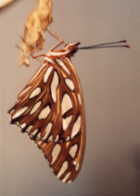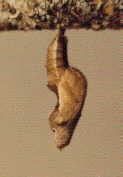Gulf Fritillary

 The Gulf Fritillary
(Agraulis vanillae) belongs to the family Nymphalidae. There are 3000 species of Nymphalidae
worldwide, with 150-160 residing or visiting in North America.
The Gulf Fritillary
(Agraulis vanillae) belongs to the family Nymphalidae. There are 3000 species of Nymphalidae
worldwide, with 150-160 residing or visiting in North America.
Members of the family Nymphalidae are more commonly known as Brush-Footed butterflies. Shared
characteristics among the Nymphalidae are shortened forelegs - hence the term "brush-footed," large
knobs at the end of the antennae, and robust, furry palpi (projections on either side of the face
which protect the proboscis).
 The adult female lay
eggs - yellow, oblong, and ribbed on Passionvine (passiflora). The emerging caterpillars are
orange in color, with black spines. Often, faint brown stripes are visible running from head to rear.
The caterpillars grow to a length of one and a half inches.
The adult female lay
eggs - yellow, oblong, and ribbed on Passionvine (passiflora). The emerging caterpillars are
orange in color, with black spines. Often, faint brown stripes are visible running from head to rear.
The caterpillars grow to a length of one and a half inches.
 The chrysalis
resembles a curled, dried leaf.
The chrysalis
resembles a curled, dried leaf.
The Gulf Fritillary is a southern butterfly, inhabiting the states along the Gulf of Mexico. It can be
found in more northerly states during the summer, but it is not a permanent resident since neither
the butterfly nor its host plant can survive the cold winter temperatures.
Despite its name and similar coloration, the Gulf Fritillary is not a true Fritillary. It is actually one of the
"longwing" butterflies, which include the Zebra Longwing (Heliconius charitonius) and Julia
(Dryas iulia) As such, it is sometimes assigned to a separate family, the Heliconiidae.
Return to Home Page
 The Gulf Fritillary
(Agraulis vanillae) belongs to the family Nymphalidae. There are 3000 species of Nymphalidae
worldwide, with 150-160 residing or visiting in North America.
The Gulf Fritillary
(Agraulis vanillae) belongs to the family Nymphalidae. There are 3000 species of Nymphalidae
worldwide, with 150-160 residing or visiting in North America. The adult female lay
eggs - yellow, oblong, and ribbed on Passionvine (passiflora). The emerging caterpillars are
orange in color, with black spines. Often, faint brown stripes are visible running from head to rear.
The caterpillars grow to a length of one and a half inches.
The adult female lay
eggs - yellow, oblong, and ribbed on Passionvine (passiflora). The emerging caterpillars are
orange in color, with black spines. Often, faint brown stripes are visible running from head to rear.
The caterpillars grow to a length of one and a half inches. The chrysalis
resembles a curled, dried leaf.
The chrysalis
resembles a curled, dried leaf.